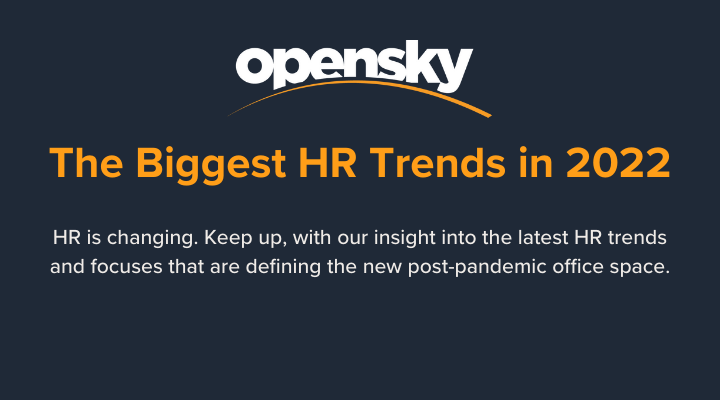The Biggest HR Trends in 2022
HR is changing all the time. If you want to make sure your processes and policies are keeping up with the shifts in the industry, you need to be sure you're adapting to these changes flexibly and quickly. Here are the latest HR Trends in 2022, and what you need to know as the HR landscape evolves.
The Biggest 2022 HR Trends You Need To Know About
1) There's more work & hiring to do than ever before, with primary focus on hiring & retention.
The past two years have given millions of people time to reconsider their careers and what they actually want to do in their lives.
A survey by Promoleaf revealed that 46% of employees felt there was a lack of support from their employers, and 45% felt overworked. People are leaving jobs they hate, and are put off by onerous, time-consuming, soul-crushing applications & admin: one survey by SHRM found that 60% of applicants stop filling out application forms due to their complexity or length.
People are unhappy with their jobs, want to try something new, or desire jobs that give them what they truly want from their lives; whatever the epiphany, this leads to employees quitting old jobs and finding new ones. Some studies predict that HR will spend 25% more time recruiting in 2022, a daunting prospect.
HR knows that it needs to respond to this challenge and the hurdles in vetting, verification, response times, internal approval that allow for fast, painless hiring; and to deal with these obstacles, HR leaders are turning to smart tools and automated solutions that cut down response and processing times to a minimum.
2) Onboarding is still a challenge – and more focus & tech is being placed on it
According to a study by Sapling, 88% of organizations still don’t onboard well. This is bad news, given how onboarding is one of the most important parts of a great company culture and strong staff retention.
One study by BambooHR found that 89% of those who received effective onboarding felt strongly integrated into their culture, compared to 59% of those who received ineffective onboarding.
To deal with the clear challenges of on-the-job distance learning, and to keep their staff retention metrics high, HR leaders are increasing their use of smart assistance, automated workflows, and complex, organised learning platforms that help newcomers to join their teams confidently and quickly.
3) Work, teams, management – almost everything is going digital
Remote work arrangement, automation, and digitisation are the new heart of HR in our post-pandemic world of work.
Research shows that 22% of employees are happier working at home, with around 51% of respondents in a FlexJobs survey stating that they have been more productive working remotely or from home during the pandemic.
To deal with this remote-first, digital-first, and Working-From-Home new world, HR teams are turning to digital and automated tools. A Sierra-Cedar HR Systems Survey found that the use of RPA tools in HR Functions increased by 50% in just a single year of the pandemic. What's more, two out of three human resources managers agree that the sector is experiencing digital transformation – but only 40% of them have a road map to approach this new phase.
As WFH and hybrid work setups become the new normal, expect the trend of digital and automated work management solutions to become as natural as using email.
4) HR managers are having to excel at more & more work, even outside traditional HR work
Not only do HR leaders have to find and hire world-class employees – they also need to create the perfect work culture and environment these newcomers will never want to leave. Additionally, HR leaders are being brought into all sorts of extra work, including project management, strategy sessions, team building organisation, wellness and culture development, and more.
Recent research has shown that 71% of heads of HR are spending more time on business issues not related to HR or talent, while 70% of heads of HR are spending more time participating in business projects in a leadership capacity.
As HR leaders are expected to do more and more work even outside the scope of their role, they'll need to find ways to get all these tasks done quickly and painlessly. Automation tools and digital technologies will be a vital tool in lowering this pressure, as they can streamline and accelerate all the new work HR leaders are being given, and even relieve them completely of some of their older manual & repetitive tasks.
5) A return to the human, with a focus on employee experience
Echoing the world's newfound desire for comfortable work arrangements, WFH, and work that brings fulfillment, HR departments are embracing the human aspect of their work. This means less focus and importance on spreadsheets, meetings, and bureaucracy that employees don't care for, and more attention on supporting employees' physical health, mental wellbeing, financial fitness, social health, workplace safety, and a healthy company & work culture.
Increasingly, we’re seeing HR and People and Culture teams take a design-led approach to improving the employee experience. This means borrowing concepts from UX and CX teams, for example, employee journey mapping, to design products and services that increase employee engagement, product, and retention.
Your HR work is changing all the time, and digital transformation is a key part of adapting to the frequent changes we're seeing in the HR industry. Automation and RPA are a vital component of meeting these new pressures and challenges: with a complimentary consultation with our HR and Automation experts, we can help you identify areas that can be automated, streamlined, or improved through some of the most cutting-edge techniques and technologies available on the market.
In our next upcoming HR expertise article, we'll explore the most critical KPIs for HR in 2022, and how you can accelerate them through Automation and RPA technology. Follow our blog or sign up for our newsletter to catch this upcoming article as soon as it's out.




